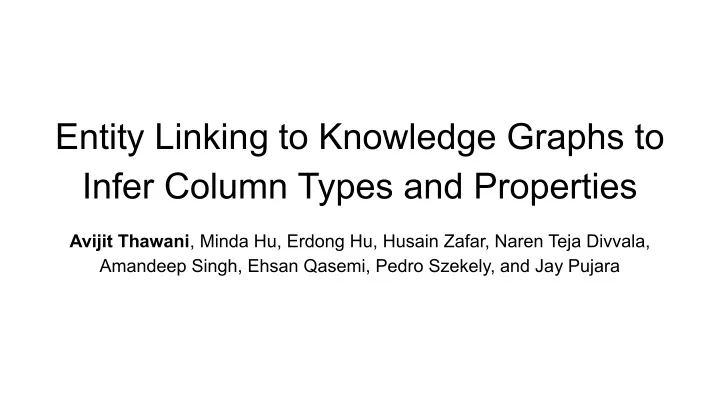

Entity Linking to Knowledge Graphs to Infer Column Types and Properties Avijit Thawani , Minda Hu, Erdong Hu, Husain Zafar, Naren Teja Divvala, Amandeep Singh, Ehsan Qasemi, Pedro Szekely, and Jay Pujara
About Us Team ISI: ● Information Sciences Institute ● University of Southern California Me: ● PhD student, USC
Outline 1. CEA 2. tf-idf 3. CTA and CPA 4. Shortcomings 5. Analysis 6. Appendix: PSL
1. CEA
Objective: CEA dbp.org/resource/Mark_Knopfler Mark Knopfler dbp.org/resource/Super_Furry_Animals Super Furry Animals dbp.org/resource/The_Killers The Killers Brian Wilson dbp.org/resource/Brian_Wilson AlunaGeorge dbp.org/resource/AlunaGeorge
Approach: CEA
Lots of Cues
Lots of Cues ● Class
Lots of Cues ● Class ● Properties
Lots of Cues ● Class ● Properties ● Values
Lots of Cues ● Class ● Properties ● Values
Lots of Cues ● Class ● Properties ● Values instanceOf: Human
Lots of Cues ● Class ● Properties ● Values
Lots of Cues ● Class ● Properties ● Values occupation: Singer
Lots of Cues ● Class ● Properties ● Values
Lots of Cues ● Class ● Properties ● Values Record Label: ...
Lots of Cues ● Class ● Properties ● Values
Lots of Cues Features ● Class ● Properties ● Values
What to do with all those Features?
What to do with all those Features? If labelled data -> Machine Learning
What to do with all those Features? If labelled data -> Machine Learning Human? occ:Singer? Record Label? ... Chef? 1 1 1 ... 0 Weights 20 30 10 ... 0.5 Confidence = 60
What to do with all those Features? If labelled data -> Machine Learning
What to do with all those Features? If labelled data -> Machine Learning If not -> Image Source: icon-library.net
What to do with all those Features? If labelled data -> Machine Learning If not -> Heuristics!
2. tf-idf
Image Source: becominghuman.ai blog
properties genre family record disco- Dbo: TF/IDF Levenshtein entities name label graphy MusicalArtist Q313013 (Brian Wilson, 1 1 1 1 1 0.98 1.0 musician) Q913269 (Brian Wilson, 0 1 0 0 0 0.64 1.0 baseball player) Q1135582 (Super Flurry 1 0 1 1 1 0.23 1.0 Animals, band) Q7642367 (Super Flurry 0 0 0 0 0 0.0 0.61 Animals Discography) Q185343 (Mark Knopfler, 1 1 1 1 1 0.99 1.0 musician) DF = document 52 31 36 15 49 frequency IDF = log 3.20 1.85 1.65 3.46 2.11
3. CTA and CPA
Objective: CTA Auckland Los Angeles dbp.org/ontology/Settlement California ... Waikato District
Approach: CTA
CPA
Results: CEA Round 1 Round 2 Round 3 Round 4 f1 precision f1 precision f1 precision f1 precision 0.884 0.908 0.826 0.852 0.857 0.866 0.804 0.814
4. Shortcomings
Shortcomings
Shortcomings Another pass needed
Shortcomings Another pass needed Custom handling of data types
Shortcomings Another pass needed Custom handling of data types Intra-row information
5. Analysis
Analysis: # Rows
Analysis: # Rows
Analysis: # Rows
Analysis: Custom Handling
Analysis: Embeddings Levenshtein Similarity tf-idf
Analysis: Embeddings Levenshtein Similarity tf-idf on Property tf-idf on feature Class feature
Takeaways
Takeaways ● Lots of Semantic Cues (not just classes)
Takeaways ● Lots of Semantic Cues (not just classes) ● When no data -> TF-IDF
Takeaways ● Lots of Semantic Cues (not just classes) ● When no data -> TF-IDF ● Revising always good
Takeaways ● Lots of Semantic Cues (not just classes) ● When no data -> TF-IDF ● Revising always good ● Over-revising is an overkill (PSL)
Takeaways ● Lots of Semantic Cues (not just classes) ● When no data -> TF-IDF ● Revising always good ● Over-revising is an overkill (PSL) ● String Similarity ⊥ Semantic Similarity
Avijit Thawani PhD student with Pedro Szekely Fin. and Jay Pujara Thank You thawani@isi.edu kia mihi
Appendix
PSL Graphical Model = Several passes!
Probabilistic Soft Logic PSL is a - Probabilistic Programming Language for easily defining - Hinge Loss Markov Random Fields - using a syntax like First Order Logic.
PSL in one slide
PSL in one slide Define closed predicates: - instance(madonna, Singer) instance(st_madonna, Saint) … - candidate(R 3 C 1 , madonna) candidate(R 3 C 1 , st_madonna) …
PSL in one slide Define closed predicates: - instance(madonna, Singer) instance(st_madonna, Saint) … - candidate(R 3 C 1 , madonna) candidate(R 3 C 1 , st_madonna) … Define open predicates: - type(C 1 , Singer)? type(C 1 , Saint)? - entity(R 3 C 1 , madonna)? entity(R 3 C 1 , st_madonna)?
PSL in one slide Define closed predicates: - instance(madonna, Singer) instance(st_madonna, Saint) … - candidate(R 3 C 1 , madonna) candidate(R 3 C 1 , st_madonna) … Define open predicates: - type(C 1 , Singer)? type(C 1 , Saint)? - entity(R 3 C 1 , madonna)? entity(R 3 C 1 , st_madonna)? Restrict with PSL rules: - 10: candidate(R x C y , Q z ) -> entity(R x C y , Q z ) - 20: candidate(R x C y , Q z ) & type(C y , T w ) & instance(Q z , T w ) -> entity(R x C y , Q z ) - entity(R x C y , Q 1 ) & Q 1 !=Q 2 -> ! entity(R x C y , Q 2 ) .
PSL output class(C 1 , Singer): 0.12 class(C 1 , Saint): 0.89 entity(R 3 C 1 , madonna): 0.23 entity(R 3 C 1 , st_madonna): 0.68
1st result baseline F1: 0.865 Precision: 0.871 Recall: 0.858 (7 datasets annotated by us)
PSL results F1: 0.903 Precision: 0.910 Recall: 0.896 (7 datasets annotated by us)
PSL without ranked priors F1: 0.777 Precision: 0.783 Recall: 0.771 (7 datasets annotated by us)
Recommend
More recommend